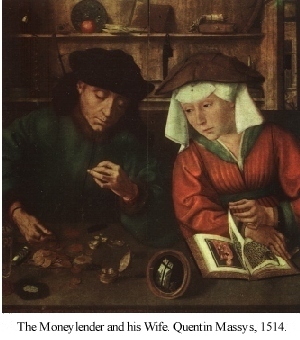End of Europe's Middle Ages
|
With the increased economic activity of the Middle Ages, there was a growing need for money exchange and the conversion of coins. Money changers were soon holding and transferring large sums of money and extending loans to merchants. As the demand increased, so did the number of services. Common financial activities came to include granting loans, investing, as well as most of the deposit, credit and transfer functions of a modern bank. |
|
|
A major obstacle to the growth of banks in the Middle Ages was the Church's prohibition of usury, the charging of interest on loans. As economic activity expanded, however, the papacy became one of the first to insist that interest should be paid on investments made at a risk. Because they were forbidden to hold land or engage in more "acceptable" sources of economic enterprise, money changers in the Middle Ages were typically Jews. After the shift in Church policy regarding usury, it became more acceptable to be a financier and attempts were made to expel Jews from their commercial role. The international luxury trade was centered in Rome during the Middle Ages. By the end of the thirteenth century, Florentines, as papal treasurers and tax collectors, spurred Florence to become the banking centre of Europe. Large numbers of families invested capital in commercial and industrial developments. In the 1290's, the Bardi and Peruzzi families had established branches in England and were the main European bankers by the 1320's. By 1338, there were more than eighty banking houses in Florence with operations across Europe. The financial success of Florentine banking activities led others to break the monopoly. During the fifteenth century, municipal banks became established, including one at Barcelona in 1401 and one a few years later at Valencia. One of the longest and most stable banks was the Bank of Saint George in Genoa, established in 1407 by state creditors and run by a board of directors. The greatest danger to Medieval banking was in granting loans to European monarchs to finance wars. The use of mercenary armies and field artillery increased the costs of mounting military operations. To finance these activities, rulers were often willing to repay loans at extremely high rates of interest sometimes as high as 45 to 60 percent. Yet if they were unable to repay the loans, they simply did not. Most of the bank failures of the late Middle Ages and Renaissance were the result of large loans to rulers who refused to pay their debts. The Bardi and Peruzzi banks suffered greatly when England's monarchs refused to pay for loans acquired to finance the Hundred Years' War. |
|

|
Return to Economy |
The End of Europe's Middle Ages / Applied History Research Group / University of Calgary
Copyright © 1997, The Applied History Research Group
